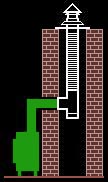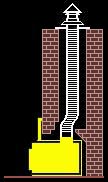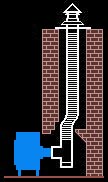|
==============================================================================
3/13/07:
Do I need to reline?
Q:
We must replace our old catalytic Scandia 310C wood stove with 8" flue
due to a cracked back panel. We use it to heat our 20x20' downstairs playroom,
and provide supplementary heat to the rest
of house. We burn maybe 2 cords a season: poplar, some oak.
In 15 yrs, we've never had any problems with it or the exterior, two-story 8" x 13"terracotta lined chimney.
The chimney and stovepipe are always "very clean,"
never much creosote, hardly any ash, lining and joints intact. Now we're told that newer stoves "require" lining
the chimney with smaller diameter flue pipe.
I understand that the warranties of some models require such, as does our county
codes department. Are there any stoves we can get that will not
require refluing the chimney? I want to meet all relevant codes; but wonder if, given
the excellent cleanliness record with our old stove, the newer
"requirements" may be a bit overstated, as in CYA, as in "idiotproof"? Are
the newer stoves truly drawing so much less air than the old Scandia, which, due to age and design,
is in no way truly "airtight"? Any advice would be appreciated, especially on possibilities of slightly less efficient
stoves that might vent into a
larger flue. Thanks so much!
Bucky Edgett
 Hi Bucky, Hi Bucky,
The flue liner requirement results from a National Fire Prevention Association flue sizing code spec that dates back many years. Briefly stated,
NFPA-211 specifies that inerior chimneys (chimneys that are contained within the
heated house until they exit the roof) cannot have a flue opening measuring more
than three times the size of the exhaust opening on the stove, and chimneys
which run up the outside of the house cannot have a flue opening measuring more than twice the size of the
exhaust opening on the stove.
The main reason for the code sizing spec is draft: if a column of
wood exhaust has to expand to several times its size to fill an oversized chimney
flue, the flow rate is reduced and the exhaust cools in the flue, resulting in smoke back-puffing and excessive creosote formation. The problem is
worse in chimneys on outside walls, as cold outdoor temperatures cool the structure, making it harder to maintain good flue gas temperatures
within. This issue has intensified in recent years, as today's super-efficient woodstoves radiate more of the heat from the fire into the house, so they
have cooler exhaust temperatures than the older models like your Scandia.
An 8 x 13 terra cotta flue liner with rounded corners has a cross-sectional area (CSA) of 100 sq.in., so
if the chimney runs up the outside of the house, no woodstove with a flue collar CSA of less
than 50 sq.in. can be vented into it unless a properly-sized liner is installed. An 8" woodstove flue collar has a CSA of 50.75 sq.in., so your Scandia
installation was juuuust barely up to code. Given the relatively hot flue gas temperatures the Scandias produced,
it's not surprising you had no
drafting or creosote problems.
Most of today's woodstoves have 6" flue collars (28 sq.in. CSA), so
code prohibits venting them into an exterior chimney with a CSA larger than 56 sq.in. This
means if you vent a stove with a 6" flue collar into your chimney, code requires that you also install a 6" stainless steel liner.
If you don't want to install a liner, you'll need to find a replacement stove with an 8" flue collar, such as the
Hearthstone Equinox.
A cautionary note: even if you choose a new stove with an 8" exhaust collar, your experience might be less than ideal. First, as mentioned above, a
new stove might not produce sufficient exhaust temperatures to get a good draft going in your oversize flue. Second, today's stoves with 8" flue
collars are SIZE LARGE, and may produce too much heat for you to bear in your 20 x 20 playroom.
==============================================================================
4/24/12:
Can I do a partial reline?
Q: I want to convert my conventional fireplace to a wood burning insert. I have a standard brick masonry chimney which is about 22 feet tall. I am
getting conflicting advice with regards to lining the chimney. One source is telling me I only have to line from the insert to about 6 feet up and
another source is advising me to line the whole thing. I need to be cost conscious and want to know how much liner to order. Any help would be
appreciated.
Regards,
Scott Arnone
 Hi Scott,
Hi Scott,
Aside from the code requirements outlined above, there are a couple more reasons you should consider a full reline. First, partial relines are
virtually guaranteed to cause the insert to operate at less-than-optimal efficiency. Second, every time your chimney is swept from then on, the
insert, sealer plate and short length of pipe will have to be removed so the swept-down creosote can be cleaned out from the smokeshelf area. This
is a heavy, difficult, messy job (and expensive if you hire it done).
==============================================================================
|




